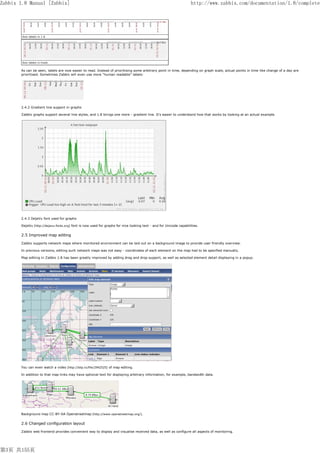
Templates (that can even link to further templates) save time in setting up many checks. Backing up the database is all there is to be done. Storage periods (aka “history”) can be configured freely. Gathered data is stored in a database (MySQL, PostgreSQL, SQLite) instead of an unflexible RRD file. Certain users can be limited to certain views. Values are by default collected every 30 seconds. Zabbix can follow a path of simulated mouse clicks on a web site and check for functionality and response time. Sophisticated monitoring of web sites. 
So you can check for the CPU load every 30 seconds but check the number of free inodes on /home just once an hour.

Each item can have a custom check interval. You don’t have to wait for several minutes until you see results (it usually takes half a minute).
Collecting items (gather information about system parameters) happens at set intervals. You will need a server with a good I/O performance and a lot of RAM though so that the database can work efficiently. This kind of data collection is very efficient. The agent can even call scripts or shell one-liners to gather information. A Zabbix agent can be installed on the systems (available for several operating systems – even for Windows) which gathers the information on each system efficiently. Notifications are completely customizable with macro variables. 
“Low disk space on /var on web5” with an additional comment is pretty helpful even when sent via SMS.
The notifications actually help the person who gets the message. Even automatic actions like restarting services can be set up. User John may just get an SMS for problems of high severity during the weekend and on weekdays get a Jabber message. Availability Monitoring (like Nagios) and graphing (like Cacti) is combined into one tool. Advantages of Zabbix comparing to other moimtoring tools:







 0 kommentar(er)
0 kommentar(er)
